The South American
republic of Peru has a Pacific seacoast of more than 1,400
miles from which the lofty Andes Mountains rise like a
majestic barrier against the plain on the east. Some of
these mountains reach a height of 20,000 feet near a coast
that drops off into an abyss of equal depth. Not only is
Peru incredibly beautiful, but also she has a legacy that
may reach back to a civilization that existed over 14,000
years ago; her location between the hemispheres made her the
navel of the earth. Is her real name
Meru? Did
her leaders become the deified god's of the ancient world?
Greek legends talk about the early ages of the world in
terms of gods and cataclysms. Couched in symbolism, they
tell about a universal mother who gave birth to the Titans,
or divine kings who formed the first race, and were later
honored as gods who brought civilization to men. Their
birthplace was a mountain from which many rivers cascaded
onto surrounding plains, altogether comprising an island
continent in the middle of the Ocean. Although this island
was known by many names to all peoples, the most popular one
is Atlantis. The story of Atlantis was allegedly left to the
Greek philosopher Plato by his ancestor Solon, who learned
it from the Egyptian priests, who told him that they had
recorded 14,000 years of history. Part of it contained the
story of Atlantis, a powerful island in the Atlantic Ocean,
that controlled some other islands and Europe. The
aggressive Atlanteans attempted to conquer the weaker
Mediterranean countries, but Athens surprised everyone by
defeating them. Shortly afterwards a great tidal wave swept
over the ocean nations.
Plato called the island Atlantis, but another writer of his
century called it Meru. Theopompus related a conversation
between the king of Phrygia and a man named Silenus, in
which the latter described a country larger than Asia,
Europe and Libya combined, beyond the Atlantic Ocean, where
a race of men called Meropes had extensive cities…"A
country where gold and silver are so plentiful they are
esteemed no more than we esteem iron.” His
description matches Plato’s, but it’s location is beyond the
Atlantic. Did Atlantis and Meru share the same island from
which Europe derived it’s name. A close scrutiny of Atlantis
reveals that Atl in the
Nahuatl language means head of the
waters…war, whereas Antis
is the Quechua word for east
which was later changed to Andes. This indicates Atlantis
may have extended from the eastern Andean slope where the
Amazon, Orinoca and Paraguay rivers begin their journey
across the great plain now covered with forest. What about
Meru?
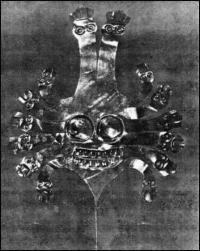
Left is the ornament worn by Peruvian priests depicting
twin serpents facing east and west ruling over their twelve
satellites. Hindu legends describe Meru as the sacred
Brahman city located upon a great mountain in the center of
the earth from which four primeval rivers, or religions,
flowed north, east, south and west…reflecting the glories of
God. She was the Greek’s Garden of Hesperides, where a
dragon named Ladon kept watch over the golden celestial
sheep; the home of Medussa with her crown of serpents, whose
magic could cause death or restoration to life. Above is the
Medussa-like ornament worn by the Nasca priests of ancient
Peru. I wonder if the two plumbed serpents at the center
facing right and left represented the twins Meru and
Atlantis ruling over their twelve satellites.
The ancient Europeans described her as the sacred Isles
of the Blessed, where their souls would be received into
sparkling glass palaces. So persistent was this belief in
the western Paradise, that the mortally wounded King Arthur
asked to be set in the sea…"for I wil into the vale of
Avilon for to heal mee of my grievous wound; and if thou
never here more of mee, pray for my soule.” Although the
ancient Europeans and Egyptians placed their dead facing the
west, the chief god’s of India came from the opposite
direction. Indra, Nahusha, and others were kings of Meru, a
mountainous island located south-east of India. Researchers
identify Nahusha as Dionysus, son of Zeus, and grandson of
Poseidon, the king of Atlantis. He established an empire
over thirteen islands of
the civilized world, and obtained the sovereignty of
three worlds, symbolized by
the three pronged scepter of the kings of Meru / Atlantis.
In the beginning Dionysus was a just king, but grew proud
and made slaves of the Brahmans. Later he was transformed
into a serpent and honored by the Greeks as the god of wine,
and Bacchus by the Romans.
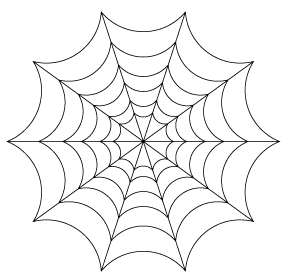
I
believe that Meru and Atlantis shared the South American
continent, but today it doesn't resemble the ancient
descriptions of a large plain with a mountain in the center.
Physical evidence indicates a large chunk of land may have
broken off along the Andean ridge. In 1971 a group
of scientists organized an expedition near the village of
Otuzco to explore mountain caves mentioned by the Spanish.
Deep within the earth they found layered caves, at the end
of which were six watertight doors made of tremendous slabs
of rock. Behind them were tunnels that led towards the coast
with a steep downward slope; the stone floors were pitted
and grooved to prevent slipping. These fifty-five to
sixty-five mile long tunnels ended abruptly eighty feet
beneath the ocean.
W. J. Thompson uncovered more evidence of a disastrous
Pacific cataclysm during the early part of the last century.
He and an old native deciphered some Easter island tablets
that indicated the island was part of a large continent of
land crossed with paved roads designed like a huge spider
web: “…In that happy land, that beautiful land where
Romaha lived with his beloved Hangarva. In that happy land
governed the gods from heaven…There the black and white
spider would have mounted to heaven, but he was held back by
the cold…” Perhaps from the air their roads looked
similar to this sketch of a spider web. Below, not far away
on the Peruvian Nasca Plain, is an immense drawing of a
spider and other forms, that were unknown until pilots
discovered them. Is the spider connected to Easter Island?
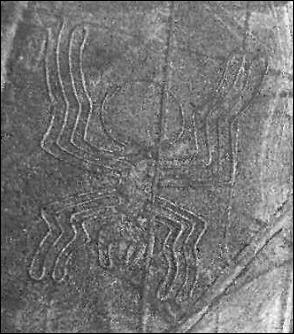
This information was taken from the writings of
Colonel James Churchward. While with
the military stationed in India during the famine, he became
friends with a priest. The Rishi taught him to decipher
glyphs on tablets that had been stored in the temple vaults
for thousands of years. These told the story of a highly
civilized people living on a continent in the Pacific Ocean.
He described the country as being Mu,
but some of the oldest writings in the world call it
Meru, the
motherland of man. She was the ruler of a
theocracy known as the Empire of the Sun.
These people were great navigators who adopted various
designs of the serpent, which became the symbols for their
colonies in the Americas, Europe, Egypt, Mesopotamia, China
and India. The national emblem of the sun symbolized the
creator Ra, while the serpent represented his creative
force. The earth representative of the Creator was the
priest-king called Ra-Mu, who wore two plumbs on his crown
as a symbol of his position. After centuries of development,
Meru suddenly exploded, and sank into the Pacific Abyss.
Some legends suggest this mishap resulted from war, and
others suppose the possibility that a large asteroid passed
too close to the earth. The following account was discovered
by the archeologist Heinrich Schliemann in an old Buddhist
temple at Lhasa, Tibet: “When
the star of Bal fell on the place where now is only the sky
and the sea, the seven
cities with their golden gates and trans-parent temples,
quivered and shook like the leaves in a storm; and behold, a
flood of fire and smoke arose from the palaces. Agonies and
cries of the multitude filled the air. They sought refuge in
their temples and citadels, and the wise Mu arose and said
to them: ‘Did I not predict all this?’ And the women and men
in their precious stones and shining garments lamented, ‘Mu,
save us!’ And Mu replied, ‘You shall all die together with
your servants and your riches, and from your ashes new
nations shall arise…If they forget they are superior not
because of what they put on but what they do, the same will
befall them!” Flames and smoke choked the words of Mu; the
land and it’s inhabitants were torn to pieces and swallowed
up by the depths.
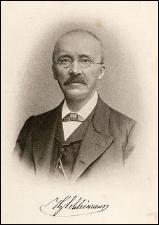
It's interesting that the seed to Heinrich Schliemann's (at
right) climb to fame began as a boy when his father read him
the ancient epic tales by the blind poet Homer, who had
lived around 850 BC. He was fascinated by Greek
myths, particularly those connected with the story of the
Trojan War, immortalized by Homer in his two epics, the
Iliad and the Odyssey. The Iliad tells the story of the
anger of the Greek warrior Achilles at Ilion, or Troy; the
Odyssey recounts the adventures of Odysseus on his way home
from Troy to the island of Ithaka. The Trojan War began when
Helen, wife of Menelaos, king of Mycenae, was abducted by
Paris, a prince of Troy. The boy Heinrich
was inspired to look for the places in the stories. As a
young man it became his goal. He married a Greek lady who
spoke the language, and in time made enough money to follow
his life long dream. The noted scientists of the time
scoffed and laughed at his quest. After all, they were
myths. Much to their embarrassment, Schliemann found Troy
and it's vast treasure that had been buried (except in
Homer's poems) for centuries. Naturally, the scientific
snobs who previously rejected him now clamored to be his
friends. Apparently, academia politics never changes.
Equally interesting was Schliemann's find regarding the
historical demise of the rich and powerful Meru written in
the old Buddhist temple.
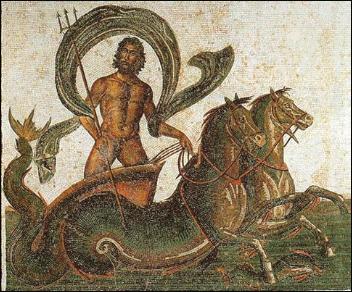
At
left is King Neptune (Poseidon) with his trident sceptor.
Anyone who has had experience with genealogy
recognizes that pronunciation of Mu could be
Mru that sounds like
Meru. As with most names there are
different spellings according to the ears and experience of
the interpreter. Perhaps the Pacific land was Meru, the
Andes Mountains were later Upa Meru, and the eastern plain
was Atlantis. These three nations may have occupied the same
continent in a hierarchy during successive periods as
depicted by the Atlantean King's three prong trident
scepter, that evolved into the cross. Their location between
the hemispheres played a significant role in the development
of the ancient world. The center of the earth's Son's of
the Sun. Etchings found on ruins and tablets throughout
the world clearly demonstrate the symbolic writing used by
the ancient priests. These symbols sometimes comprised whole
structures that could be seen from the sky.

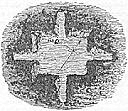
The picture at the right was a mound in the Ohio Valley. One
of the most ingenious symbols was the ancient Greek cross
(left) composed of a crossed circle within a larger circle.
The outer circle represented the universe, while the inner
circle denoted the terrestrial earth within it. The cross
showed the center of the world from which knowledge flowed
into the various hemispheres much like the rays of the sun
streaming from their source; the source was the central
government of the Empire of the Sun. This symbol was very
versatile. Removing the circles leaves a trident, or three
prong scepter of the later design. Drawing a line from the
cross bar to the top of the center post on either side
creates the triangle, or earlier scepter. Extending the
outer lines to the base of the post makes a pyramid, or
celestial mountain.
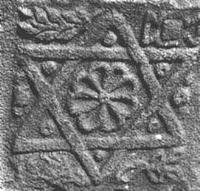
The invisible lines of the equator and meridian divide the
earth into four hemispheres that cross in the west near
Howland Island in the Pacific Ocean, and just below Ghana,
Africa in the Atlantic Ocean. Imagine a great pyramid rising
miles above the earth using these crosses and the
north/south poles for footings. The summit appears off the
Peruvian coastline, placing South America within all four
points of the earth in an area that could be described as an
immense diamond composed of two triangles. Moving these two
triangles towards the equator creates a uniting the forces
from above with those from below; a symbol representing the
twelve planets of our solar system with their counterpart
"islands" below, that also revolved around a central sun.
The triangle's lines comprise the North pole, Howland
Island, South pole and Ghana Gulf. King Solomon's Seal
indicated he was a Son of the Sun. Each
side of the points equals 12 (Tribes of Israel?). The legend
of King Solomon's Seal, of the wondrous signet ring which he
received from heaven, is common to Judaism, to Christianity
and to Islam. King Solomon's Seal, whose base is on the
ground and whose tip reaches heaven, symbolizes a harmony of
opposites, whose significance is manifold as much as it is
multi-cultural. It reflects the cosmic order, the skies, the
movement of the stars in their spheres, and the perpetual
flow between heaven and earth, between the elements of air
and fire. The Seal, therefore, symbolizes super-human wisdom
and rule by divine grace.
Colonel Churchward estimated the plain of Mu (Mru) to have
been 5,000 miles wide and 3,000 miles long. The giant
crossed sun symbol marked a spot between East, North, West,
and South; it's traditional role kept alive by the Inca
royalty initiated into the Huaracu, or hierarchy during
which time the candidates wore white shirts with a cross
embroidered on the front. The monarch also preserved the
custom of wearing a four colored fringed turban on his head,
in which two upright plumbs from the Corquenque bird were
placed like those of his ancestor Ra-Mu.
The Legends of the Jews, compiled by Louis
Ginzberg, mention that the creation of the world began
when God threw a fire-stone into the waters. The story
mentions that Adam and Eve were born in a place at the
center of the earth named Ahuzan. Later they
migrated to another land. Rabbinical discussions describe
their priestly robes. The Creation story in Genesis says
that after God rested He placed a man named Adam
eastward in an area stretching from Egypt's Nile (Gihon)
to India's Ganges (Phison)...the area that comprised the Ad
Empire. He breathed his breath into Adam, meaning Adam was a
priest ( a Son of God symbolized by the Sun) who
taught about God. The Adamites (pre-Israelites) made their
appearance during the seventh day, or age following the
creation of men and women in the image of the god's, during
the sixth age...who in turn replaced the creatures with
souls that crawled out of the waters in the previous age.
These references indicate at least two major cataclysms
during pre-historic times.
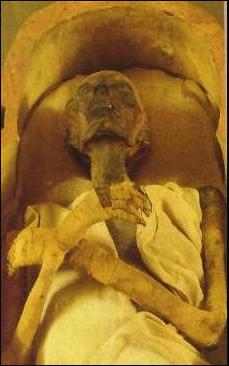
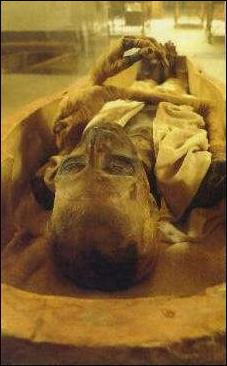
The fact that Adam was placed eastward suggests that the
people of the sixth generation (or age) lived in
the west. The popular theology says that the earth was
created in six ordinary days. According to scripture, those
were the generations of creation. A day can be
1,000 or a million years. It wasn't until after the
Sabbath that God created Adam and Eve, who were not the
first people, but rather the first of a dynasty. Don't
forget the women who married Adam's sons, or the mysterious
talking snake who shared their world. The name Adam means
different things in various dialects ranging from "red" to
"first." Ancient Arab legends mention that the Ad's who
built the pyramids were of large stature, red-haired (to
blond), reddish complexioned men.
In these two pictures
you can see the tufts
of red hair on the mummified remains of the Egyptian pharaoh
Ramses II. He died in the 12th Century B.C. after ruling
Egypt 67 years. Ramses built two temples at Abu Simbel, one
for him and one for his favorite royal wife Nefertari. Below
is the Nefertari temple, with the Queen standing between
statues of Ramses.

Since the name Adam means different things in various
dialects ranging from red to first and we
now can assume that Adam probably had reddish, or blond
hair. But where does first come into the picture? The
biblical story appears to be a symbolical history of the
Adamic / Israelite people and their struggle with two
theologies that starts with the Genesis 3:15 allegory that
is thoroughly explained in the cross-reference in Galatian's
chapter four. Clearly you have the bond woman of
priestly ritual, magic and law. The free woman needs
none of it to communicate with God. Man's religion
represents his spiritual side, and the Bible
characterizes these organizations as women of various moral
character depending upon their practices. Adam was obviously
the first of a dynasty of priest-kings (similar to
the Catholic Papacy), a Son of the Sun. His religion became
corrupted with the sacrificial black magic of another
religion. The legends of the Jews indicate that Adam and Eve
wore priestly robes, and the first Eve sacrificed
thousands of first born children...as was the practice
during Abraham's time. It was revived during Solomon's time
(in the Valley of the Children) and condemned in the Book of
Micah when the author asks God what offering would be
acceptable. His answer was that the Creator wanted none of
it (including the children), but rather... Micah worship his
god humbly and be kind to his fellow beings. Moses got the
people to substitute animals for children, but Jesus Christ
freed the minds of men by becoming the final sacrifice; thus
a new and better pattern for humanity. He put an end to a
terrible religious practice. The old rites are still
noticeable in the Christian Communion, but wine or grape
juice is substituted for blood and bread for flesh to
remember what Christ did for humanity...lest we forget and
lapse into the dementia of former times. His martyrdom freed
men's minds and lifted their consciousness to a better way
of life here and hereafter. His teachings are the
cornerstone of America's Constitution and greatness.
However, since there's nothing new under the sun that hasn't
been done during other times under different names and
costumes, you can usually find the old practices symbolized
in in many things we do today...as with the firstborn being
sacrificed to the fertility god for prosperity.
Some theologians may not agree. However, there are as many
opinions as there are body parts. My opinions come
from studying the writings and thoughts of our Founding
Fathers and the Old King James Bible with cross-references
and both Hebrew and Greek translations. It's a marvelous
bible to study. An elderly Lutheran minister once told me
that "No one knows how to do it anymore." It's too
bad. The cross references and comparable translations reveal
that there's more to the texts than what first meets the
eye. Kind of like putting the pieces of a puzzle together
until you see a greater picture. As your experience and
knowledge grows, so does your understanding of what you
read. No wonder it is often described as being a living
book.
The Egyptian priests told the
Greek historian Herodotus that they had descended from the
oldest men on earth, who lived in the west. This gives
credence to the idea that Adam and Eve were priests who left
civilization in the west and migrated eastward to teach
about the Creator. A Hindu legend mentions that Adima and
Heva dwelt upon an island, which they left to reach the
mainland, before a terrible disaster occurred.
There are many legends about
terrible natural events. One tells what happened when a
large celestial body passed to close to the earth. The
atmosphere turned an ominous blood red, then grew dark as it
filled with dust from the comet's writhing tail. Lightning
crackled between the two bodies, as it grew closer,
providing a frightening spectacle to the onlookers. "The
events in the sky were viewed by the peoples of the world as
a fight between an evil monster and a light-god who engaged
the monster in battle...the tail of the comet leaping back
and forth under the discharge of the flaming globe of the
comet." After a few days of darkness, searing hurricane
winds that whipped and burned the groaning earth, a violent
shock caused the ocean to break over the continents. The
mountain of water reduced populated areas to mud and gravel.
One of the best books for scholars of ancient legends and
artifacts is "Atlantis, The Antediluvian World," by
Ignatius Donnelly. The entire text can be found on
the internet
http://www.sacred-texts.com/atl/ataw/.
In Chapter IV he quotes an Iranian fundamental Zorastrian
doctrine that could be considered one of the great flood
stories. It relates how Yima (the father of the human race),
was warned by Ahuramazda (the good deity) about an impending
flood. Yima was told to construct a protected enclosure to
store all the germs of men, beasts and plants to escape
annihilation. After the inundation, Yima's enclosure
survived...and the message of safety was brought to him by
the bird Karshipta, the envoy of Ahuramazda. Most
investigators of antiquity realize that it was customary for
ancient people to deify their rulers. The bird Karshipta,
being the envoy of Ahuramazda sounds very much like an
airship. Don't laugh, because there are lots of stories
about aircraft in religious texts. The Bible mentions
Enoch's fiery steed that ascends into the heavens, and
Ezekiel's wheels within wheels and the terrible crystal. And
don't forget Moses' pillar of light. Ginzberg's Legends of
the Jews further describes Enoch's steed that killed those
standing too close as they watched him take off. Mohammed
claimed to have received his inspired messages from a nearby
star when he was on the mountain.
Donnelly relates an ancient Chaldean legend about a man
named Khasisatra who lived during the time of the deluge.
Evidently "the gods took council on the appeal of Anu...and
a deluge was proposed by Bel...and approved by Nabon, Nergal
and Adar." Sounds much like the United Nations
Organization of that day. The lord Ea, knew about it and
advised Khasisatra to quickly build himself a ship, and
instructed him how to do it. When it was finished,
Khasisatra gathered his wife, provisions, worldly
possessions, servants, "son's of the people" and
various animals inside the ship. Then Shamash told him he
was going to make it rain that evening, so he'd better get
into the ship and close the door. Shortly after that, a
black, thundering cloud emerged and divested the mountains
and plains. The cloud became an inundation that
swelled up to the sky making the earth look like a desert.
Men couldn't see one another, and even the gods were
frightened of the water spout. During the six days of wind,
the combination waterspout-earthquake swept humanity into
the muddy abysmal sea. On the seventh day it grew calm.
Corpses floated like seaweed in a tremendous sea that
covered everything except a mountain called Nizir. Finding
his ship blocked by the mountain, Khasisatra sent out a
raven that never returned, so he prepared a burnt sacrifice
to thank the gods for his deliverance. The smoke attracted
the attention of the gods who hovered above him like
luminous crystals. However, the smoke also caught the
attention of the warrior Bel, who stopped to see what was
going on. He cried out angrily, "No one shall come out
alive! No man shall be preserved from the Abyss!" Adar
and Ea soothed him into mercifully letting the poor
frightened man and his group live. Then Bel entered the ship
and took Khasisatra by the hand and asked him and his wife
to stand up. The lord turned around them and stopped short;
then he approached the rest of the group saying:
"Until
now Khasisatra and his wife were made part of perishable
humanity; but lo, now Khasisatra and his wife are going to
be carried away to live like the gods, and Khisisatra will
reside afar at the mouth of the rivers."
Khasisatra said he was carried away to remote place at the
mouth of the streams. Berosus says the god who gave the
warning of the deluge was Chronos, the youngest brother of
the Titans.
Another Chaldean story relates that Xisuthros and his family
and friends took shelter in a vessel just before the summer
solstice to escape a flood that was expected to drown
everyone. He was told to steer his boat towards the gods.
After a few days he discovered his vessel had grounded on
the top of a mountain. He and his family and pilot left the
boat and raised an altar on which they made a sacrifice. At
that moment he and those with him vanished! When they didn't
return to the ship, those left on board began to search for
them, but a voice from the sky commanded them to worship the
gods, and not to seek Xisuthros and his companions, because
they had been carried away to live with the gods.
I
chose these particular deluge legends because they reveal an
advanced society, masquerading as gods. Khasisatra and his
wife were carried away to a remote place at the mouth of the
rivers, by the fearsome lord Bel. Xisuthros was instructed
to steer his boat towards the gods, after which he and some
others were physically removed and flown where? Yima
received re-assurance from a group that arrived in a Karship
that flew like a bird. Did the lord Auramazda who sent the
envoy, live on the Andes mountains? During the catastrophe
the western plain of South America may have broken off,
whereas the eastern plain was partially submerged making
that part of the Atlantic muddy for many years. This event
occurred around the time the last mastodons and horses
disappeared from the American continent...around 14,000
years ago. The memory of it was kept alive in the Inca
summer Solstice Festival of Raymi, the Aztec
New Fire Ceremony, and the Hebrew Jubilee. In
all three cases the end of the world was preceded by
repentance, prayer, and fasting. Following the dreaded time,
a new Sun emerged, and the week long festival of the
resurrection began.
Don't you wonder about the ancient lords of flight who
carried the survivors of the flood away to live with them?
The most vivid descriptions of their aircraft were recorded
in Hindu manuscripts, which were probably written about
events that took place long before the Sanskrit migration.
James Churchward mentions a manuscript describing them. They
were called Vimana's, capable of using magnetic
energy from the atmosphere. Once they were turned on they
could circle the earth indefinitely until they either wore
out, or were turned off. Some flight records alleged they
ran from 1,000 to 3,000 miles. Here's one of his
descriptions:
"When morning dawned, Rama, taking the celestial car
which
Pushpaka had sent to him by Vivpishand) stood ready to
depart. Self-moving was that car; it was large and finely
painted. It had two stories and many chambers with windows
and was draped with flags and banners. It gave forth a
melodious sound as it coursed along it's airy way."
Author Rene Noorbergen wrote that these celestial cars, or
aerial chariots, were also used for destructive purposes:
"The
Vimanas were used in battle. An eighteen day war between the
Kawavas and Pandavas who inhabited the upper regions of the
Ganges....Shortly after a second battle was waged against
the Vrishis and Andhakas in the same region. They used a
terrible weapon: 'The violent Adwattan, remaining steadfast
in his Vimana, landed upon the water and from there
unleashed the Agneya weapon...Taking careful aim against his
foes, the preceptor's son let loose the blazing missile of
smokeless fire with tremendous force. Dense arrows of flame,
like a great shower, issued forth upon creation
encompassing the enemy. Meteors flashed down from the sky. A
thick gloom of the compass were lost in darkness. Fierce
winds began to blow. Clouds roared upward, showering dust
and gravel....!" (Mahabharata)
This account reminds me of the passionate Lord of the old
testament who destroyed Sodom and Gomorrah with some
terrible weapon; and Ezekiels attempt to describe a craft of
wheels within wheels that sounded like the noise of
great waters, in which he saw the terrible crystal.
Were these aircraft the same as those used by the lords who
circled around Khasiasatra, and carried him away?
Equally interesting is
the legendary origin of the Incas of Peru. The first Incas
are supposed to have emerged from a House of Windows,
from the place of the Sun, under the leadership of four
brothers bearing the title Ayar. The eldest was a priest of
the sun named Manco. among their possessions was a
basket that gave them directions to search north for
the empire. They also had a gold rod that would sink into
the ground when the place was found. During their search the
three younger brothers died. Cashi returned to get some
things from a cave, and was betrayed by his Indian escort
who rolled a large rock against the entrance. Uchu
accidentally seized a mysterious statue, and was turned to
stone, in the area later named Huanacauri. The third brother
Auca was asked by Manco to fly
to the top of a distant hill, where he also turned to stone.
Eventually the group reached the hill, and the test of the
gold rod established the site of Cuzco, which means
navel of the empire.
My husband and I had an
interesting experience during a logging conference in Reno,
Nevada many years ago. One of the guest speakers was an
immensely tall gentleman who operated a sawmill in Peru for
a few years. He related an experience he and an Olympic
basketball player had during a plane flight over the
forest. They developed engine trouble and had to make an
emergency landing near an Indian village. The villagers were
delighted that these two giants dropped in on them just like
their ancient gods had done centuries before. They
happened to be celebrating the event and were going to
include the lumberman and basketball player's drop from the
sky in future celebrations. I was delighted to hear the
story, because at that time Secrets of the
Mountain was my thesis for Writer's Digest
School in 1984. After the lecture I cornered the speaker to
ask if he knew anyone in Peru who could give me some old
legends. He wrote the address of a priest on my program.
Much to my dismay I later discovered that I'd managed to
throw the wrong program away and lost it.
It is now 2012. I wrote
this story in 1984 during which time we have witnessed the terrible Indian
Ocean and Japan Tsunamis that resembled what
happened in the past. I find it interesting that the Bible
is both history and prophecy; and that it compares the rise
and eventual fall of
civilization (as in the days of Noah and Lot) like
forcasting the weather by observing the prevailing human
conditions. Time brings many physical
changes to the landscape, but human nature remains the same
unless effort is made to improve it. Sigmund Freud
(the father of psychoanalyst) observed that
"civilization can only be obtained by giving up the lusts
that lurk in our unconscious-unbridled sexual gratification,
murder, incest, sadism, and violence. Only when man has
mastered his impulses can he turn his energy into creative,
civilizing channels." In other
words, through self discipline individuals
achieve marvelous things, and create great nations. The
opposite human behavior brings them down as evidenced by the
cyclic rise and fall of civilizations.
Top
Back
Back to Encounters
References